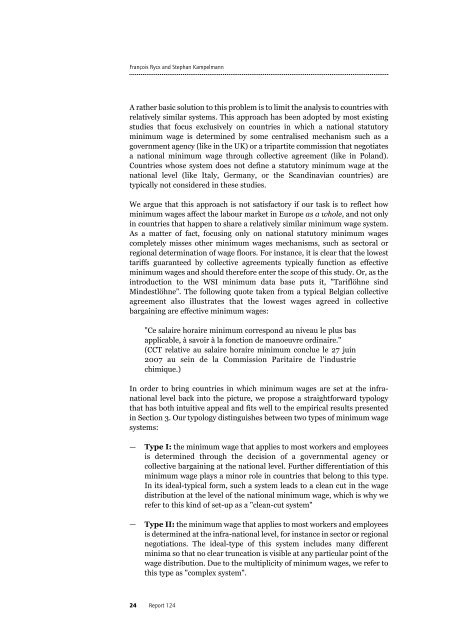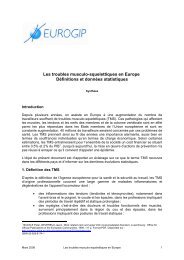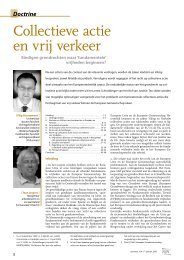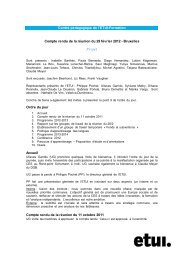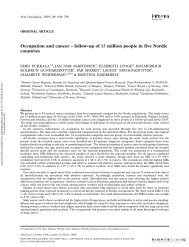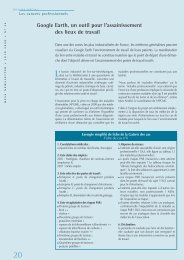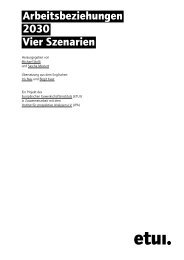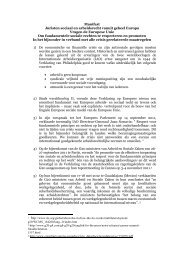Who earns minimum wages in Europe - European Trade Union ...
Who earns minimum wages in Europe - European Trade Union ...
Who earns minimum wages in Europe - European Trade Union ...
You also want an ePaper? Increase the reach of your titles
YUMPU automatically turns print PDFs into web optimized ePapers that Google loves.
François Rycx and Stephan Kampelmann<br />
A rather basic solution to this problem is to limit the analysis to countries with<br />
relatively similar systems. This approach has been adopted by most exist<strong>in</strong>g<br />
studies that focus exclusively on countries <strong>in</strong> which a national statutory<br />
<strong>m<strong>in</strong>imum</strong> wage is determ<strong>in</strong>ed by some centralised mechanism such as a<br />
government agency (like <strong>in</strong> the UK) or a tripartite commission that negotiates<br />
a national <strong>m<strong>in</strong>imum</strong> wage through collective agreement (like <strong>in</strong> Poland).<br />
Countries whose system does not def<strong>in</strong>e a statutory <strong>m<strong>in</strong>imum</strong> wage at the<br />
national level (like Italy, Germany, or the Scand<strong>in</strong>avian countries) are<br />
typically not considered <strong>in</strong> these studies.<br />
We argue that this approach is not satisfactory if our task is to reflect how<br />
<strong>m<strong>in</strong>imum</strong> <strong>wages</strong> affect the labour market <strong>in</strong> <strong>Europe</strong> as a whole, and not only<br />
<strong>in</strong> countries that happen to share a relatively similar <strong>m<strong>in</strong>imum</strong> wage system.<br />
As a matter of fact, focus<strong>in</strong>g only on national statutory <strong>m<strong>in</strong>imum</strong> <strong>wages</strong><br />
completely misses other <strong>m<strong>in</strong>imum</strong> <strong>wages</strong> mechanisms, such as sectoral or<br />
regional determ<strong>in</strong>ation of wage floors. For <strong>in</strong>stance, it is clear that the lowest<br />
tariffs guaranteed by collective agreements typically function as effective<br />
<strong>m<strong>in</strong>imum</strong> <strong>wages</strong> and should therefore enter the scope of this study. Or, as the<br />
<strong>in</strong>troduction to the WSI <strong>m<strong>in</strong>imum</strong> data base puts it, "Tariflöhne s<strong>in</strong>d<br />
M<strong>in</strong>destlöhne". The follow<strong>in</strong>g quote taken from a typical Belgian collective<br />
agreement also illustrates that the lowest <strong>wages</strong> agreed <strong>in</strong> collective<br />
barga<strong>in</strong><strong>in</strong>g are effective <strong>m<strong>in</strong>imum</strong> <strong>wages</strong>:<br />
"Ce salaire horaire <strong>m<strong>in</strong>imum</strong> correspond au niveau le plus bas<br />
applicable, à savoir à la fonction de manoeuvre ord<strong>in</strong>aire."<br />
(CCT relative au salaire horaire <strong>m<strong>in</strong>imum</strong> conclue le 27 ju<strong>in</strong><br />
2007 au se<strong>in</strong> de la Commission Paritaire de l'<strong>in</strong>dustrie<br />
chimique.)<br />
In order to br<strong>in</strong>g countries <strong>in</strong> which <strong>m<strong>in</strong>imum</strong> <strong>wages</strong> are set at the <strong>in</strong>franational<br />
level back <strong>in</strong>to the picture, we propose a straightforward typology<br />
that has both <strong>in</strong>tuitive appeal and fits well to the empirical results presented<br />
<strong>in</strong> Section 3. Our typology dist<strong>in</strong>guishes between two types of <strong>m<strong>in</strong>imum</strong> wage<br />
systems:<br />
— Type I: the <strong>m<strong>in</strong>imum</strong> wage that applies to most workers and employees<br />
is determ<strong>in</strong>ed through the decision of a governmental agency or<br />
collective barga<strong>in</strong><strong>in</strong>g at the national level. Further differentiation of this<br />
<strong>m<strong>in</strong>imum</strong> wage plays a m<strong>in</strong>or role <strong>in</strong> countries that belong to this type.<br />
In its ideal-typical form, such a system leads to a clean cut <strong>in</strong> the wage<br />
distribution at the level of the national <strong>m<strong>in</strong>imum</strong> wage, which is why we<br />
refer to this k<strong>in</strong>d of set-up as a "clean-cut system"<br />
— Type II: the <strong>m<strong>in</strong>imum</strong> wage that applies to most workers and employees<br />
is determ<strong>in</strong>ed at the <strong>in</strong>fra-national level, for <strong>in</strong>stance <strong>in</strong> sector or regional<br />
negotiations. The ideal-type of this system <strong>in</strong>cludes many different<br />
m<strong>in</strong>ima so that no clear truncation is visible at any particular po<strong>in</strong>t of the<br />
wage distribution. Due to the multiplicity of <strong>m<strong>in</strong>imum</strong> <strong>wages</strong>, we refer to<br />
this type as "complex system".<br />
24 Report 124


